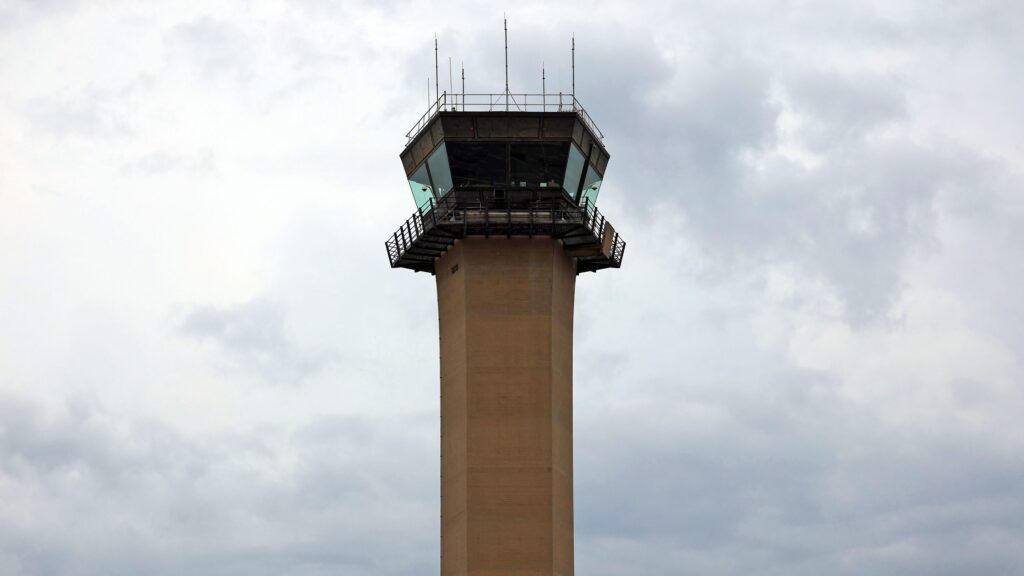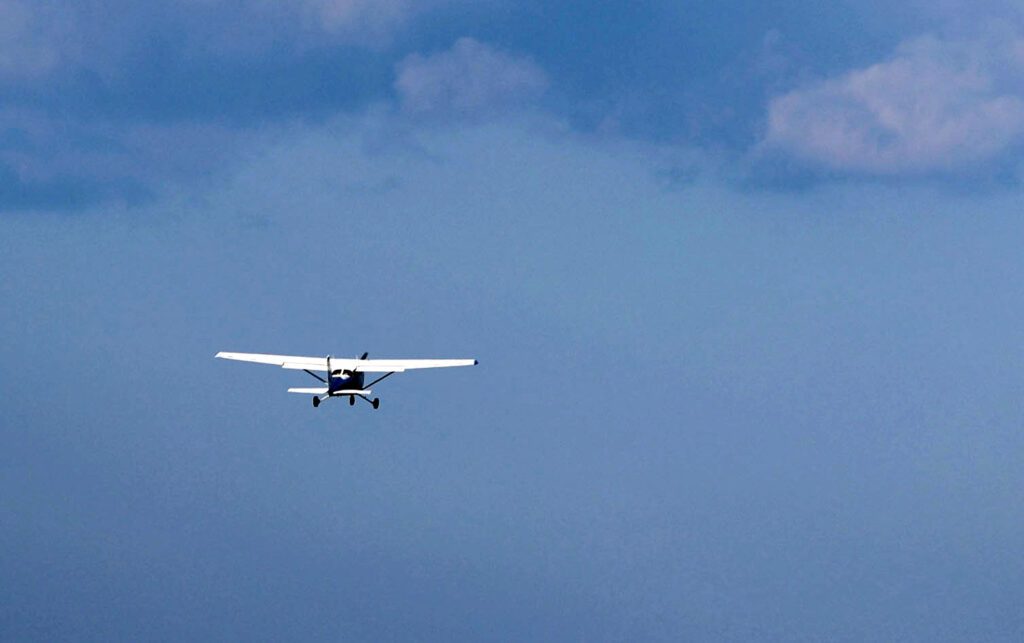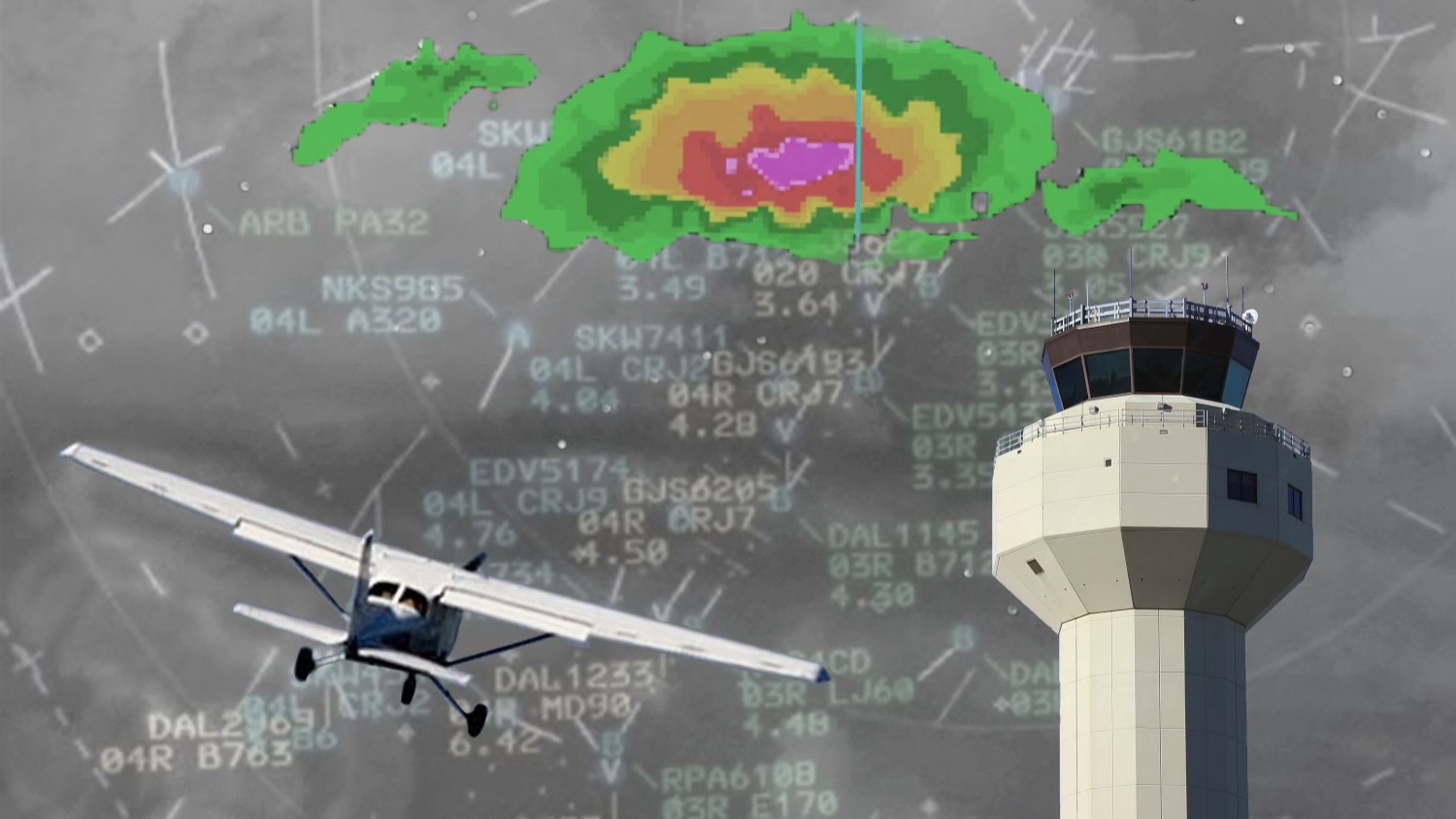Disoriented and alone, the young pilot in a newly purchased used plane flying over northern Florida found himself unexpectedly inside thick, dark clouds in torrential rain. In a panicked voice, he called over his radio: “Lost in weather, please! Can you see me? Can you see me?”
More than 100 miles away, a Federal Aviation Administration air traffic controller in the Jacksonville Air Route Traffic Control Center answered the pilot’s plea for help over a guarded radio frequency specially designated for emergencies: “This is Jacksonville Center on Guard. Do you know your approximate position?”
For the next 35 minutes, guided by powerful radar, the distant FAA controller gently directed the wayward pilot with a measured and encouraging voice as the life-and-death crisis grew more dire. Imagine driving a speeding car at night in heavy rain without headlights or reflective lane markers. The small plane was a half-mile high.
Such stories play out across the United States with surprising frequency, often with no fanfare and out of earshot of the traveling public. To pilots, especially ones in mortal danger, air traffic controllers are voices at the end of a lifeline, saviors of the skies. On the ground, they are average people, exposed to the threat of emotional trauma and juggling high-risk problems in one of the most stressful jobs in America.
“We’re kind of the behind-the-scenes heroes that nobody knows,” said Kerri Fingerson, a Boston controller who earned a top safety award from the FAA. She said her coworkers are “doing all the work to make sure that you get there safely.”
In this case, the controller reassured the pilot he had personally experienced such frightening whiteout conditions that can be fatally disorienting: “I want you to know, I’m a pilot, too,” he said. “I’ve been in the same situation, and I know it’s a little bit scary but we’re going to get you through it. You’re doing a great job, just keep listening to what we’re telling you.”
What played out in the skies that fall afternoon of Nov. 14 reflected interchanges between pilots and controllers when a crisis happens. The FAA provided a recording of the radio traffic that day — which has never been fully described until now — to Fresh Take Florida, a news service at the University of Florida’s College of Journalism and Communications, under the U.S. Freedom of Information Act.
At one point, the confused pilot — feeling dizzy and with no points of reference outside his cockpit except storm clouds for miles in every direction — literally didn’t know which way was up. He shouted into his radio, “I am upside down, I believe! I do not know where I am!”
The controller calmly answered: “You’re not upside down. I’m showing your altitude is level. If you were upside down, you’d be falling,” he said. “Let’s just take a real deep breath. It looks like you’re doing OK. I show you’re leaving 2,400 (feet) at this time. Looks like you’re tracking straight north right now. Let’s just hold the aircraft in its attitude right now, and we’ll work on that.”
Then things got much worse.



In the United States, about 23,000 air traffic controllers direct more than 70,000 flights daily to their destinations, according to government figures. Controllers track planes simultaneously, instructing pilots at every stage of flight from takeoff to cruising to landing — sometimes dealing with life-or-death emergencies, even talking with pilots moments before they crash.
To airline passengers, the harried and stressful work of controllers is entirely out of sight. Commercial jet travel is safer than ever: Last year, there were no fatal accidents aboard commercial flights in the U.S., according to the International Air Transport Association, the Montreal-based trade group for the world’s airlines. The last major fatal crash in the U.S. was in 2009, when 49 people died after a regional jet crashed into a house a few miles from the airport in Buffalo.
The picture isn’t nearly as safe among general aviation pilots. It’s a broad category covering recreational flying, flight training, medevac operations and even firefighting and banner towing. Over the last decade, there have been nearly 1,000 accidents each year — and scores of deaths — involving private pilots and their passengers, according to the Aircraft Owners and Pilots Association, the Frederick, Maryland-based trade association that advocates for general aviation.
When these pilots falter — flying into bad weather, suffering mechanical or health problems — air traffic controllers can be their only hope. In some cases, their stories end safely. Sometimes they don’t.



Over the grasslands and swamps of Florida, the young pilot was Adrien Valentine, 21, of Melrose, a small town in the north-central part of the state. He first called out to the Jacksonville controller about 45 minutes into his flight from Kissimmee, near Orlando, last year, when he said he mistakenly flew into bad weather near Gainesville.
During a dangerous situation in the air, altitude is life. Height gives a pilot more time to fly and navigate safely, use the radio to ask for help and consider options.
The controller instructed Valentine to level his wings and slowly climb. He was, at one point, just 500 feet above the ground. The controller reassured him: “Let’s not make any control inputs, and let’s just take a breath and kind of make sure we get everything squared away for right now.”
The identity of the stalwart controller remains a mystery, for now. The FAA and the controller’s union declined to name him or permit him to participate in news interviews until the National Transportation Safety Board, the federal agency that investigates such cases, publishes its final report on the matter. Its full report could come as soon as five months from now.

After the ordeal, the actions of the controller earned wide praise. Veteran pilots said he did everything possible.
This wasn’t a private conversation: Scores, even hundreds, of other pilots and aviation enthusiasts who were monitoring the Guard frequency in the region at that moment heard every word during the drama, from beginning to end. At times over the radio, pilots admonished each other to avoid talking, so that the pilot in trouble had the controller’s full attention.
“Everybody else, shut up on Guard,” one said.
At another point — about 20 minutes after he called out for help — Valentine sounded panicked and believed he would crash. He said he was floating out of his seat, indicating the start of a dive toward the ground, and asked the controller to tell his parents he loved them.
Another pilot tried to calm him over the radio: “Take a deep breath,” he said. “Remember, fly the airplane. Aviate first, fly the airplane.” Eight seconds later, another pilot wondered aloud over the radio what to do, asking, “Can we be of any help?”
Valentine was alone in the cockpit, but he wasn’t alone.
Valentine’s first challenge in the torrential rain was getting his Cherokee Piper 180 out of a spiraling turn. The plane was nearly three times older than its new pilot. He had purchased the four-seat plane, originally built in 1964, just two weeks earlier. Valentine reported that vital instruments, including the turn coordinator and attitude indicator, had failed but it wasn’t clear whether he was still unfamiliar with its cockpit or confused with panic.
In the end, at the direction of the controller, he focused on an old school, magnetic compass atop the instrument panel to try to stay on course.

Valentine was a certified private pilot but had only about 66 hours of flying experience. When he took off that afternoon, he had just one hour of experience using his instruments. He did not have an instrument rating, an additional, optional certificate for private pilots that enables them to fly in low visibility, when weather may disorient a pilot so severely they can’t rely on their physical instincts to fly. A 1991 study by the University of Illinois — still cited in aviation circles — estimated the life expectancy for pilots in such scenarios at 178 seconds before they spiral to their deaths.
The controller checked in: “November-Zero-Six-Whiskey, are you still with me?”
“Still with you,” Valentine said. It had been 12 minutes since he called for help.



Communicating with pilots is no easy feat. Controllers must be concise but clear. Speak professionally but not in jargon. Before being certified, new hires complete training courses and attend the FAA’s academy for up to five months in Oklahoma City. The FAA also requires controllers to have a bachelor’s degree or a few years of work experience.
Even then, controllers often undergo more training once assigned to a new airspace.
Communicating with less-experienced pilots can be entirely different. Some lack instrument ratings, which require 90 combined hours of flight experience and 15 hours of instruction from a professional.
Air traffic controllers like Christopher “Chip” Flores, 40, of Fort Pierce on Florida’s east coast, sometimes assist pilots who are learning how to fly in poor weather conditions for the first time.
“In any kind of stressful situation, the way you say things matters,” said Flores, who worked as an FAA air-traffic controller at Treasure Coast International Airport, which also put him into frequent contact with students and new pilots from a local flight school.
“You always have to have kind of a calm tone of voice,” he said. “They can hear over the frequency if you’re getting emotional and that’s going to make them emotional and not be able to perform. You have to be really conscious how you’re coming across.”
In May 2022, the pilot of a single-engine Cessna Caravan, Kenneth Allen, with two passengers aboard over the Atlantic Ocean said he wasn’t feeling well and collapsed unconscious during a return trip from Bahamas.
As the passengers moved the pilot from his seat, the plane’s autopilot disengaged and it dived toward the ocean below. Passenger Darren Harrison wasn’t a pilot, but he had been around small planes enough. He was able to level the wings.
“My pilot has gone incoherent,” Harrison said over the radio. “I have no idea how to fly the airplane, but I’m maintaining 9,100 feet.”
Flores instructed Harrison to descend to 5,000 feet, to avoid hypoxia in case a lack of oxygen had affected the pilot. He searched for the aircraft on his radar and called into the air traffic control tower in nearby Palm Beach, which controls the Fort Pierce airspace.
Harrison descended below where Fort Pierce’s radio frequencies could operate — communication became difficult. Flores couldn’t raise the plane over the radio.
“I was talking to him and now I’m not,” he said, “and that’s all I knew for about another 10, 15 minutes.”



Back over north-central Florida, the young pilot lost in weather was feeling sick. Valentine couldn’t tell looking out the windows, but he was spiraling in tight turns, losing then gaining altitude. “Uh, I feel very sick and all of my instruments appear to me to have failed,” he said.
“OK, that’s all right,” the controller told him. “We need you, you sound like you’re calming down a little bit. I want you to just hold the yoke neutral where you’re at right now.”
He added: “Let your head stop spinning and just keep tracking south. You’ve got 3,500 feet of altitude. You’re in a good position right now.”
Minutes later, the plane climbed to 5,400 feet, further into the storm clouds. Aware of the threat of a crash, the pilot’s instincts were to climb toward safety. He asked how high he needed to fly to be above the huge storms, to break into sunlight.
Commercial jet pilots in the area reported thick clouds as high as 35,000 feet — far higher than the Piper could fly. The controller wanted him to fly lower — toward the danger of the terrain — to see whether he could peek under the clouds and regain his bearings.
“If you get down below (2,000 feet), you may see some ground and you’ll be able to orient yourself,” he said.
Instead, the small Piper climbed over the next four minutes to 5,600 feet, then to 6,300 feet, up to 7,000 feet. Inside the plane, still suffering from vertigo, the pilot felt like he was falling.
“I’m starting to lose altitude rapidly,” he shouted.



Inside the Cessna coming from over the Atlantic with an unconscious pilot, Harrison, the passenger at the controls, was talking to Robert Morgan, an air traffic controller at the West Palm Beach tower. Morgan had taken over for Flores in Fort Pierce. Supervisors selected Morgan, 49, to help Harrison because of his experience as a flight instructor.
“I was honestly really nervous of failing,” Morgan said. “But I did try to not let that show.”
The plane was closest to Boca Raton airport. But Morgan decided its congested runway would be too difficult for Harrison. He instructed Harrison to turn toward Palm Beach International Airport 25 miles to the north, using local landmarks like Interstate 95 as reference points.
In the background, Morgan’s supervisors brought him a diagram of the cockpit of the plane – one that Morgan had never flown.
“I did whatever I could do to get a successful outcome,” Morgan said.

Morgan guided the plane on a straight approach descending slowly toward the landing strip. When the plane was over the runway, he coached Harrison how to keep the nose off the ground until the main landing gear touched down. After Harrison applied the brakes, he didn’t even know how to turn off the engine. He asked Morgan for help shutting down, as emergency crews assisted the pilot off the plane.
“Honestly, I was thinking, ‘Why did I pick up this overtime shift?’” Morgan said. “But, at the same time, I had all this flight experience. I know how the pilot is feeling. When you’re learning to fly and then you have to go solo, it’s like, ‘Oh God, now I gotta do it by myself,’ so I tried to put myself in his shoes.”
The National Air Traffic Controllers Association honored both Morgan and Flores for their heroism with its annual Archie League Medal of Safety Award.
Archie W. League, who was stationed in St. Louis, is regarded as the first air traffic controller — he popularized communication with the pilots in the 1930s, using just red and checkered flags to direct planes, hold and go. Now, each year in Las Vegas, the awards celebrate remarkable controllers around the country. The union’s president selects the flight assistance that was most inspiring.
“I always said it’s an award that I hope that I don’t ever win,” said Fingerson, a controller at the Boston Air Route Traffic Control Center, “because it means that I was in a situation where we were very close to losing a pilot.”
Fingerson won the award in 2022.



Fingerson, 36, was at the Fort Worth Air Route Traffic Control Center in Texas in April 2021 on the radio with the pilot of a small plane who missed several landings amid heavy rain and poor visibility. Spring storms in the Southwest can be violent and unpredictable.
She said she remembers advice from Tammie Jo Shults, one of the first women to serve as a Navy fighter pilot and who later flew for Southwest Airlines: “Habits become instinct under pressure.”
The pilot with one passenger aboard was trying to land at Clinton Regional Airport in Oklahoma. Twice in heavy thunderstorms, the pilot abandoned his landing attempt because he couldn’t see the runway safely.
“We got to do something quick,” the pilot said.
The pilot asked where Fingerson could direct him to better weather. Her answer: Wichita Falls Regional Airport, nearly 150 miles to the south in Texas. But he had only 55 minutes of fuel left. He asked to make a third landing attempt and said he was confident he would make it this time.
“To me, that didn’t sound like a great idea,” she said. “That sounds to me like you’re going to do something dangerous.”
Instead, Fingerson worked quickly to help the pilot land at Lawton-Fort Sill Regional Airport, much closer to the south. He made it to the ground with 14 minutes of fuel remaining.
“Fort Sill, Oke City,” she radioed, wondering if the pilot landed safely. “Did he make it?”
“Yeah, he did,” the controller told her.
In an interview, she said, “I remember that night when I got off shift, calling my husband and being like, ‘I think I saved two guys’ lives tonight. And then I really didn’t say a whole lot more about it.”



Aboard the Piper, in the storm clouds, conditions were worse. Valentine was so close, only seven miles from the nearest airport in Gainesville. He said he was feeling sicker, a result of the tight turns he was inadvertently flying.
The controller tried to comfort him: “OK, that’s because you’re coming out of that turn. So, you’re going to start to feel a bit of that. I want you to just keep listening to what we’re coaching you through, and you’re going to start feeling a bit of that. But you’re doing very well. You’re still flying the airplane, and you’re doing great listening to us. I want you to just keep doing what you’re doing right now.”
Valentine dreamed of becoming a commercial pilot and had worked at Gainesville’s airport refueling and handling small planes and jets. That day in the sky, he was doing what he loved to do, flying a plane, his family said.
The controller directed the pilot to fly a path toward the Gainesville airport, but the Piper kept turning.
“I’m losing, losing altitude rapidly,” Valentine said.



Flying over Georgia, pilot Cathy Lewan, 65, of Madison, was in a small Cessna 172-S in February 2016, saw smoke in the cockpit and told an air traffic controller that her plane’s throttle, which controls engine power, was malfunctioning. She prepared for an emergency landing and thought about her mortality.
Lewan, a pilot for 25 years, declared an emergency with the FAA approach control in Peachtree City, Georgia.
There, controller Mason Braddock, who had been working with a team behind the scenes, directed Lewan to circle the busy Hartsfield-Jackson Atlanta International Airport. For 50 minutes, she dodged planes above, below and beside her while avoiding a stall several times and being unable to control her speed. On the ground, Lewan’s team prepared emergency vehicles in case her plane caught fire while landing.
“I should be able to knock this out,” Lewan said over the radio. “I’m so, am so sorry for all those emergency people sitting down there waiting on me.”
Braddock answered: “That is absolutely the reason we’re here. We’re here for you.”
In an interview, Lewan said: “I saw all these red lights racing to the runway. I said out loud, ‘They think I’m gonna die.’”
Over the radio, Lewan asked Braddock to call her husband and pray for her: “His name is Roland, and if you could ask him to put a prayer chain out to my church and ask the whole church to start praying, and everybody else that’s listening,” she said. “I need to tell him that I love him and call my mother. And I know I’m going to be fine because you’re helping me, and the good Lord is helping me, but I always need prayer.”

The controller reassured her: “We’re going to call him right now for you and we’ll make sure everyone knows, we’re taking good care of you.”
“It’s going to be fine,” he said.
Lewan said it took nearly an hour to land — partly because the team of controllers was preparing for her, and also because she wasn’t quite ready herself. That week, Lewan recalled feeling emotionally raw, having attended a family member’s funeral a day earlier and knowing that her father had died in a plane crash with controllers who weren’t so reassuring.
That wasn’t the case with Braddock, Lewan said. “He was firm when he needed to be and he was gentle when he needed to be,” she said.
Braddock and his team also earned Archie awards. Lewan, the pilot they saved, attended the ceremony.
“It can be very ominous and overbearing when you’re falling and flying and you’re in the midst of a lot of chaos and you have just some voice on the other end,” she said. “But when you’re in a crisis and you can feel that that’s a person on the other end working with you – I felt that the entire time. It was very comforting.”
Months after she landed safely, Lewan pressed the FAA to allow her inside the control tower to learn more about those who helped save her. She discovered how surprisingly nonchalant controllers can be.
“They’re all in jeans and T-shirts,” she said. “But when there’s any type of emergency, and something they’ve never dealt with before, too, they’re like, ‘Oh, OK.’”
Still, controllers suffer pressure more than they recognize.
Neurobiologists measured stress levels of air traffic controllers in a 2020 academic study by outfitting 16 of them with devices measuring their brain activity, heart rate and the skin’s electrical changes, then put them through a 60-minute simulator directing flights around Istanbul’s airport. At times, planes were headed toward each other. One pilot declared an emergency and had to land immediately.
The stress measured in the controllers’ brain waves was far higher than the controllers described they felt during the simulation. The stress, researchers said, “significantly” affected their performance. A separate academic study last year said U.S. controllers regularly suffer insomnia, heart issues, obesity and relationship issues caused by stress.



When pilots die, controllers can suffer – and in ways that aren’t plainly obvious.
Before Morgan worked at the Palm Beach tower, he remembered a colleague on the job in North Carolina helping a pilot, whose family was aboard, fly a plane with a malfunctioning autopilot. The plane flew erratically in the clouds, eventually spinning and diving toward the ground. All three died.
“I saw the ending to that, and the controller, it really affected him,” Morgan said. “He knew when the guy was going to crash. He just slammed his hand on the table and he cursed something.”
Mental health is a growing concern within the aviation industry, especially among controllers who experience stress in the towers. After a death, controllers can receive help from an FAA stress team, made up of colleagues who offer support. The FAA also gives controllers time off work after an accident.
“It’s very sobering when something like this happens,” said Josh Flowers, 28, a flight instructor known for his YouTube channel, Aviation101. “After the sadness and the heaviness of a situation has gone, the comforting thing that we all do in aviation is come back to the safety conversation. How can we improve from this?”



Back in Florida, the desperate effort to rescue the 21-year-old pilot had been underway for 35 minutes since Valentine’s first call for help.
The controller saw on radar that Valentine’s plane was flying toward the ground and urged him to gently level his wings: “I want you to pull back on the yoke just a little bit, just a little bit,” he said. “Let’s get that descent rate arrested.”
He repeated, a few seconds later, “Pull back just a little bit.”
Valentine asked the controller again to tell his parents he loved them. In his final message directly to his mother and father, he said, “I love you.”
Seconds later, the plane disappeared from radar as it crashed into a state park south of Gainesville. The NTSB said its preliminary inspection of the plane’s engine and controls found no obvious mechanical problems.

“We deeply appreciate the efforts of everyone, especially those of the ATC, on the worst day of our lives,” Russell and Kathleen Valentine said. “We miss him dearly.”
The controller kept calling for the pilot: “November-Zero-Six-Whiskey, are you still with me?”
“November-Zero-Six-Whiskey, Jax Center. How do you hear?”
There was no answer.
This story was produced by Fresh Take Florida, a news service of the University of Florida College of Journalism and Communications. The reporter can be reached at lauren.brensel@ufl.edu. You can donate to support the students here.






